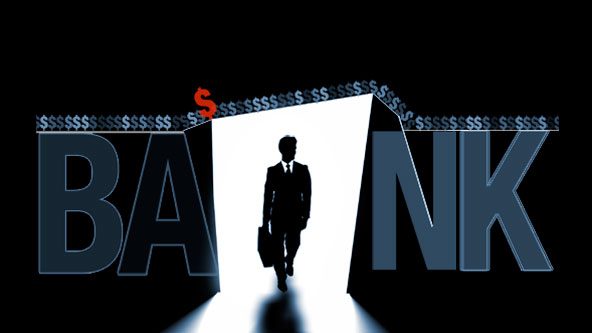 金融可通过两种方式给我们带来灾难。其一涉及有系统重要性的大型金融机构倒闭:例如上世纪初的尼克波克信托公司(Knickerbocker Trust Company)和本世纪初的雷曼兄弟(Lehman Brothers)。其二则涉及某一特定市场爆发动荡:例如1673年的郁金香市场和2008年以各种形式存在的“影子银行”。过去三年,对大型银行监管问题的讨论很多,但进展却有限。近期爆出的伦敦银行间同业拆借利率(Libor)丑闻有助于增强推进银行监管的动力。但影子银行改革一直停滞不前,这是由于没有人愿意认真思考“钱究竟是什么”这一基本问题。
金融可通过两种方式给我们带来灾难。其一涉及有系统重要性的大型金融机构倒闭:例如上世纪初的尼克波克信托公司(Knickerbocker Trust Company)和本世纪初的雷曼兄弟(Lehman Brothers)。其二则涉及某一特定市场爆发动荡:例如1673年的郁金香市场和2008年以各种形式存在的“影子银行”。过去三年,对大型银行监管问题的讨论很多,但进展却有限。近期爆出的伦敦银行间同业拆借利率(Libor)丑闻有助于增强推进银行监管的动力。但影子银行改革一直停滞不前,这是由于没有人愿意认真思考“钱究竟是什么”这一基本问题。
为了说明这一问题的重要性,我们先从影子银行业的支柱之一——资产支持证券(ABS)谈起。由于这类债务凭证在金融危机爆发前看似安全,因此它们在事实上被当做了现金等价物:交易员们用资产支持证券来支付衍生品头寸的保证金,押注失误平仓时还用其结算。很多资产支持证券卖给了货币市场基金,这使进一步强化了它的现金等价物地位。货币市场基金属于保本型投资,其基金账户可用于签发支票。再以规模庞大的“回购”市场为例。任何持有证券的人——无论是国债、公司债还是前面提到的资产支持证券——都可通过回购市场将其换为现金。实际上,在金融危机爆发前夕,甚至连只由一堆华尔街空洞承诺构成的合成债务抵押债券(synthetic CDO)也可不费周折地换作现金。金融家们变魔术般地“无中生钱”。货币创造已不再是中央银行的特权。
当然,私人货币是一个由来已久的现象。银行过去曾能自行发钞,即使是简单无比的活期账户,也是建立在这样一种大胆的构想上:你友善的银行经理在你账户上登入的100美元,与价值100美元的小麦或黄金同等真实可靠。但不论由谁发行,私人货币都很容易受到恐慌冲击。因此,随着时间的推移,私人部门具有不确定性的承诺让位于坚实可靠的国家信用。1863年起,联邦储备银行用美元取代了银行纸钞。1934年,它们又设立了存款保险来保护银行账户免受恐慌冲击。
关于影子银行的关键问题是,监管当局是否应把以上“炼金术”重演一遍。监管当局在某种程度上已然在这么做了,美联储(Fed)理事丹尼尔·塔鲁洛(Daniel Tarullo)近期在一次演讲中就提到了这一点。在金融危机最为严重的时期,货币市场基金遭遇大规模赎回,两天内基金规模缩小了十分之一;与此同时,回购市场面临崩溃的危险。为防止灾难发生,美联储迅速展开纾困。像1863年和1934年时一样,政府为脆弱的私人部门承诺提供了担保。
金融危机现已退去,接下来该做些什么呢?目前大西洋两岸都急于修复影子银行体系这条管道:监管当局希望货币市场基金持有缓冲资本,它们还打算降低回购市场对清算银行巨额融资的危险依赖。虽然这些计划很有价值,但政策制定者们没有抓住金融市场面临的核心难题。资产支持证券、货币市场基金以及回购市场是否应被看作是私人货币体系?未来这些机构是否有资格获得更多纾困?这些纾困措施最终依赖于中央银行提供的紧急贷款。
要对以上问题做出正确判断,必须先回答另一个问题:如果政府将其对影子银行的担保正式化,谁将从中受益?一个答案是储户。资产证券化的爆炸式发展在一定程度上是受全球对安全资产的渴求推动,这一点在美国表现得尤为突出。在金融危机爆发前的四年里,外国政府购买了约80%新发行的美国国债以及半官方性质的机构债券。美国发行的官方储备资产不足以满足投资者需求,因此非官方储备资产成倍增长以填补缺口。另一个答案是,向影子银行提供担保可提升金融效率。在资产证券化出现以前,银行在发放贷款之后持有贷款资产,购买银行股票的投资者得到的是一个不透明的风险敞口组合。现如今,在资产证券化的帮助下,投资者可专门挑选适合自身特点的风险资产。借款人则通过向投资者提供了更优的风险管理选择降低了融资成本。为保持这一优点,美联储纾困影子银行的积极性应该与纾困普通银行不相上下。
以上回答的说服力如何?这两个答案都有值得反驳之处。储户可能确实渴求安全资产,但没有任何规定要求美国必须无限量提供这类资产。实际上,华尔街令人眼花缭乱的金融创新生成的看似安全的资产为美国引来了过剩的资金,导致美元币值被高估并助长了经常账户赤字,这应该不是政策制定者们愿意看到的。
同样,上述关于影子银行提升效率的说法也应谨慎对待。银行把资产证券化,部分是为了将其转移至不受监管因而也没有资本缓冲的基金;资产证券化的动力是监管套利,而不是效率。与此类似的是,将银行与货币市场基金、对冲基金连接起来的复杂的影子银行贷款链条,在理论上也许是有效率的:它们将分散在金融体系内的资金转移到使用效率最高的机构手中。但迂回的贷款链条存在断裂的风险。一旦断裂发生,相关纾困成本肯定又要由纳税人来承担?
不论你对这些问题有何见解,真正令人担心的是在公共领域完全听不到相关讨论。相对于去解答如下这些基础问题,抨击银行家以及他们的奖金在政治层面上更为容易:准货币是真正的货币吗?如果是,那么成立条件是什么?除非这些问题得到解答,否则金融领域将难以取得突破。我们仍将面对隐性担保而非显性保险,仍将遭遇道德风险而缺乏必须管控其后果的清醒认知。不论你倾向于如何理解货币,这种认识层面上的混沌很可能会在私人与公共金融体系引发双重灾难。
There are two ways finance can inflict disaster upon us. The first involves the collapse of a large, systemic institution: the Knickerbocker Trust at the start of the last century, Lehman Brothers at the start of this one. The second involves a convulsion in a particular market: tulips in 1637, various forms of “shadow banking” in 2008. The past three years have brought much debate and modest progress on regulating the megabanks, and the Libor scandal has added fresh impetus to these efforts. But shadow-bank reform has remained, well, shadowy. This is because nobody wants to grapple with the basic question of what money really is.
To understand the stakes, start with one pillar of the shadow banking world: asset-backed securities. Because these IOUs seemed safe before the crisis, they were treated effectively as money: for example, traders used them to make downpayments on derivatives positions and settle up if they made a wrong bet. Many asset-backed securities were sold to money market mutual funds, which enhanced their cash-equivalence further. The money market funds never lost value and you could write cheques against them. Or consider the enormous “repo” market. Anybody who owned securities – government bonds, corporate bonds or the aforementioned asset-backed ones – could use this market to swap them for cash. Indeed, in the run-up to the crisis, even synthetic collateralised debt obligations, consisting of nothing more substantial than a bunch of Wall Street promises, could be turned into money with few questions asked. Financiers were conjuring money out of nothing. By no means was this the exclusive province of central banks.
Of course, private money is an old phenomenon. Banks used to issue private banknotes; and even the humble current account is based on the audacious notion that a $100 entry on a statement from your friendly bank manager is as real and reliable as $100 worth of wheat or gold. But, however pedigreed, private money is susceptible to panics. And so, over the years, uncertain private promises have given way to solid public ones. Starting in 1863, the Feds replaced private banknotes with greenbacks. In 1934 they panic-proofed bank accounts by instituting deposit insurance.
The big question about shadow banking is whether the authorities should perform this alchemy again. To a certain extent, they have already, as Federal Reserve governor Daniel Tarullo described in a recent speech. In the heat of the crisis there was a run from money market funds, which lost a tenth of their deposits in a two-day period; meanwhile, the repo market threatened to collapse. To prevent catastrophe, the Feds rushed to the rescue. As in 1863 and 1934, flimsy private promises were fortified by government.
Now that the crisis has receded, what next? On both sides of the Atlantic there is an earnest push to fix the plumbing of the shadow banking system: regulators want money market funds to hold capital buffers; they aim to reduce the repo market’s precarious reliance on vast financing from clearing banks. But, though these initiatives are valuable, policy makers are not grappling with the core dilemma. Should asset-backed securities, money market funds and repo be viewed as a private system? Or should they be entitled to expect more rescues in the future – rescues that depend ultimately on emergency lending from the central bank?
The right judgment on these questions must depend on another one: if governments formalised the backstop, whom would they serve? One answer is savers. Particularly in the US, the explosion in securitisation was partly a response to a global craving for safe assets. In the four years leading up to the crisis, foreign official purchasers bought roughly 80 per cent of all new Treasury and semi-government agency bonds that were created. The US was not issuing enough official reserve assets to satiate investors so unofficial reserve assets multiplied to fill the gap. A second answer is that backstopping the shadow banks would promote the efficiency of finance. Before securitisation, banks made loans and held them; investors who bought bank shares got an opaque bundle of exposures. Now, thanks to securitisation, investors can cherry-pick the risks that suit them. Better risk-management options for investors means cheaper capital for borrowers. To preserve that advantage, the Fed should be as willing to rescue shadow banks as normal banks.
How persuasive are these answers? Both invite robust retorts. Savers may crave safe assets, but nowhere is it written that Uncle Sam must provide them in unlimited amounts. Indeed, Wall Street’s promiscuous creation of seemingly safe securities pulled excess capital into the country, fuelling an overvaluation in the dollar and a current account deficit that policy makers should not want to underwrite.
Likewise, the claim of shadow bank efficiency should be treated with caution. Banks securitise assets partly to transfer them to unregulated funds that don’t have capital cushions; the driver is regulatory arbitrage, not efficiency. Similarly, the complex shadow bank lending chains that link banks to money market funds to hedge funds may theoretically be productive: they shift capital around the system to the players that deploy it best. But serpentine lending chains involve a risk of breakage. Must taxpayers be on the hook for that?
Wherever you come down on these questions, what is really striking is their absence from the public square. It has been politically easier to chase bankers and their bonuses than to reckon with these fundamental problems: is quasi-money real money? If so, under what conditions? Yet until we resolve these issues, large swaths of finance will exist in limbo. There will be implicit guarantees but not explicit ones. There will be moral hazard but no honest recognition that its consequences must be managed. Whatever your preferred understanding of money, this intellectual muddle promises the worst of both worlds.
 金融可通过两种方式给我们带来灾难。其一涉及有系统重要性的大型金融机构倒闭:例如上世纪初的尼克波克信托公司(Knickerbocker Trust Company)和本世纪初的雷曼兄弟(Lehman Brothers)。其二则涉及某一特定市场爆发动荡:例如1673年的郁金香市场和2008年以各种形式存在的“影子银行”。过去三年,对大型银行监管问题的讨论很多,但进展却有限。近期爆出的伦敦银行间同业拆借利率(Libor)丑闻有助于增强推进银行监管的动力。但影子银行改革一直停滞不前,这是由于没有人愿意认真思考“钱究竟是什么”这一基本问题。
金融可通过两种方式给我们带来灾难。其一涉及有系统重要性的大型金融机构倒闭:例如上世纪初的尼克波克信托公司(Knickerbocker Trust Company)和本世纪初的雷曼兄弟(Lehman Brothers)。其二则涉及某一特定市场爆发动荡:例如1673年的郁金香市场和2008年以各种形式存在的“影子银行”。过去三年,对大型银行监管问题的讨论很多,但进展却有限。近期爆出的伦敦银行间同业拆借利率(Libor)丑闻有助于增强推进银行监管的动力。但影子银行改革一直停滞不前,这是由于没有人愿意认真思考“钱究竟是什么”这一基本问题。
